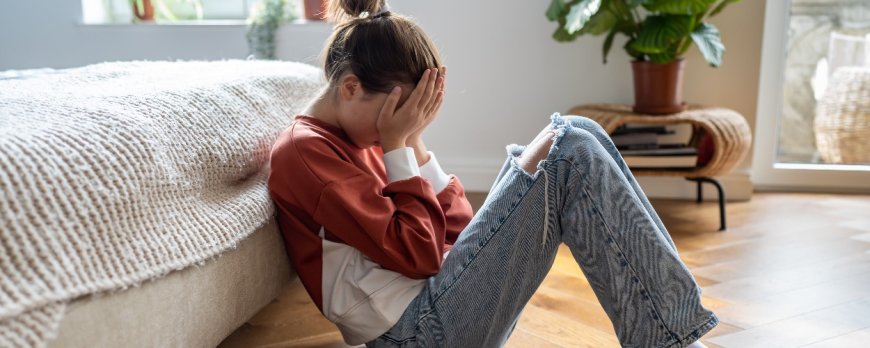What does anxiety feel like physically?
Uncover the physical toll of stress with 'What does anxiety feel like physically?' Learn about symptoms, signs, and coping strategies right here.

What does anxiety feel like physically?
Anxiety can have a profound impact on the body, leading to a range of physical symptoms and sensations. These symptoms may vary from person to person, but common physical manifestations of anxiety include stomach pain, nausea, headache, insomnia, weakness or fatigue, rapid breathing, pounding heart, sweating, trembling or shaking, and muscle tension or pain.
Key Takeaways:
- Anxiety can cause various physical symptoms such as stomach pain, nausea, headache, insomnia, weakness or fatigue, rapid breathing, pounding heart, sweating, trembling or shaking, and muscle tension or pain.
- Different types of anxiety may have additional specific symptoms.
- Long-term effects of anxiety can include an increased risk of ulcers, asthma, heart problems, migraines, and vision problems.
- Seeking help for anxiety is crucial as it can be associated with other mental health conditions and physical health problems.
- Treatment for anxiety may involve therapy, medication, and self-care techniques such as exercise, relaxation techniques, and prioritizing sleep.
It is important to consult with a healthcare professional for a proper diagnosis and appropriate treatment for anxiety. They can provide guidance and support in managing the physical symptoms and improving overall well-being.

Common physical symptoms of anxiety
Anxiety can manifest in various physical symptoms, including stomach pain, nausea, headaches, and difficulty sleeping. These symptoms can be distressing and have a significant impact on both your physical health and daily life. It is important to recognize and address these symptoms to better manage your anxiety.
Some common physical effects of anxiety include:
- Rapid breathing: Anxiety can cause your breathing to become fast and shallow, often leading to a feeling of breathlessness or tightness in the chest.
- Pounding heart: Many individuals with anxiety experience a racing or pounding sensation in their chest, which may be accompanied by an increased heart rate.
- Sweating: Anxiety can trigger excessive sweating, even in situations where it may not be warranted.
- Trembling or shaking: Some people with anxiety may experience trembling or shaking in their hands or other parts of their body, which can be noticeable to others.
- Muscle tension or pain: Anxiety can cause muscles to tense up, leading to discomfort or even pain in various areas of the body, such as the neck, shoulders, or jaw.
It is essential to seek help if you are experiencing these physical symptoms along with anxiety. These symptoms can indicate a more significant underlying issue, and it is crucial to address them for your overall well-being and quality of life. Treatment options for anxiety may include therapy, medication, and self-care techniques such as exercise, relaxation techniques, and prioritizing sleep. Consulting with a healthcare professional is advisable to receive a proper diagnosis and determine the most appropriate treatment plan for your individual needs.
Breathing and Cardiovascular Symptoms
Anxiety can lead to changes in breathing patterns and cardiovascular symptoms, such as rapid breathing and a pounding heart. These physical manifestations of anxiety are a result of the body's natural stress response, commonly known as the fight-or-flight response.
Rapid breathing: When anxiety kicks in, the body may increase its breathing rate to take in more oxygen, preparing for potential danger. This can lead to hyperventilation, which may cause dizziness or lightheadedness.
Pounding heart: Anxiety triggers the release of stress hormones, such as adrenaline, which can cause the heart to beat faster and harder. This response is the body's way of preparing for physical action in response to perceived threats.
It is important to note that these breathing and cardiovascular symptoms during anxiety are generally temporary and subside once the perceived threat has passed or the anxiety is effectively managed. However, if you experience persistent or severe symptoms, it is advisable to consult a healthcare professional for a proper diagnosis and appropriate treatment.
Managing Breathing and Cardiovascular Symptoms
- Practice deep breathing exercises to help regulate your breathing and reduce rapid breathing.
- Engage in relaxation techniques, such as meditation or progressive muscle relaxation, to calm the body and reduce cardiovascular symptoms.
- Engage in regular physical exercise to promote overall cardiovascular health and reduce anxiety symptoms.
- Consider seeking therapy, such as cognitive-behavioral therapy, to learn effective coping strategies for managing anxiety and its physical manifestations.
- Consult with a healthcare professional about potential medication options that may help manage anxiety symptoms and alleviate breathing and cardiovascular symptoms.
Remember, anxiety is a common condition that affects many people, and seeking help is an important step towards managing its physical and emotional impact on your life.
Sweating and Trembling: Common Physical Responses During Anxiety
Sweating and trembling are common physical responses during periods of anxiety. When anxiety takes hold, it can manifest in various physical sensations, and sweating and trembling are among the most prevalent. These bodily reactions are natural responses to the stress and fear that anxiety triggers.
During moments of high anxiety, your body's "fight or flight" response is activated, leading to increased sweat production. Sweating helps regulate body temperature and is the body's way of cooling down in stressful situations. The sweat produced during anxiety can be more noticeable, leading to feelings of dampness and discomfort.
Trembling or shaking is another common physical response to anxiety. It is often caused by the release of adrenaline and increased muscle tension. Trembling may range from subtle vibrations to more pronounced shaking, depending on the intensity of the anxiety. This physical manifestation can be distressing but is usually temporary and subsides once the anxiety passes.
Managing Sweating and Trembling During Anxiety
- Practice deep breathing exercises to help regulate your body's response to anxiety and reduce sweating and trembling.
- Engage in regular physical activity that promotes relaxation, such as yoga or tai chi.
- Consider using relaxation techniques, such as progressive muscle relaxation or guided imagery, to help alleviate anxiety-related sweating and trembling.
- Identify triggers that cause anxiety and work on developing coping strategies to manage them effectively.
- Ensure you are getting adequate sleep and practicing good self-care, as fatigue and stress can exacerbate anxiety symptoms.
Remember, sweating and trembling are normal physical responses to anxiety. However, if these symptoms persist or significantly interfere with your daily life, it is important to seek help from a healthcare professional. They can provide a thorough evaluation, diagnose any underlying conditions, and recommend appropriate treatment options that may include therapy, medication, or a combination of both. With the right support, you can effectively manage anxiety and improve your overall well-being.

Muscle Tension and Pain
Anxiety can lead to muscle tension and discomfort, causing pain and stiffness. When you experience anxiety, your muscles may tighten up as a result of the body's natural stress response. This can lead to aches and pains in various areas of the body, such as the neck, shoulders, back, and jaw.
In addition to the physical discomfort, muscle tension caused by anxiety can also impact your mobility and flexibility. You may find it difficult to move freely or perform everyday tasks without experiencing pain or limitations. This can further contribute to feelings of stress and frustration.
To help alleviate muscle tension and pain associated with anxiety, it is important to practice relaxation techniques. Deep breathing exercises, progressive muscle relaxation, and yoga can help release tension and promote relaxation throughout the body. Regular exercise, such as walking or gentle stretching, can also help relieve muscle stiffness and enhance overall well-being.
Here are some strategies to manage muscle tension and pain:
- Practice deep breathing exercises to promote relaxation and reduce muscle tension.
- Engage in regular physical activity, such as walking or yoga, to improve flexibility and relieve muscle stiffness.
- Consider incorporating relaxation techniques, such as progressive muscle relaxation or meditation, into your daily routine.
- Avoid activities that exacerbate muscle tension, such as prolonged sitting or repetitive motions.
- Ensure you are getting enough rest and prioritizing quality sleep, as lack of sleep can contribute to muscle tension.
Remember, if you are experiencing persistent muscle tension or pain due to anxiety, it is important to consult with a healthcare professional for a proper diagnosis and appropriate treatment options. They can provide guidance and support to help you manage your anxiety symptoms and improve your overall well-being.
Long-term effects on health
Prolonged anxiety can have significant impacts on long-term health, increasing the risk of various physical conditions. The constant activation of the body's stress response system can take a toll on multiple bodily systems, leading to a range of health issues. Here are some potential long-term effects of chronic anxiety:
- Ulcers: Chronic anxiety can increase the risk of developing ulcers, which are open sores that form in the lining of the stomach or small intestine. The excessive stress and anxiety can disrupt the protective mucus barrier in the digestive tract, allowing stomach acid to damage the lining.
- Asthma: Anxiety has been linked to an increased risk of developing asthma or worsening existing asthma symptoms. Stress and anxiety can trigger asthma attacks by causing inflammation and constriction of the airways.
- Heart problems: Prolonged anxiety can contribute to the development of heart problems, including high blood pressure, irregular heartbeat, and an increased risk of heart disease. The constant release of stress hormones can strain the cardiovascular system over time.
- Migraines: Anxiety can be a trigger for migraines, which are recurring headaches typically characterized by severe pain, nausea, and sensitivity to light and sound. The physical tension and stress associated with anxiety can contribute to the onset of migraines.
- Vision problems: Chronic anxiety may also have an impact on vision health, with some individuals experiencing symptoms such as blurred vision, eye strain, and eye twitching. Stress can affect blood flow to the eyes and cause muscle tension that affects visual perception.
It is important to recognize the potential long-term effects of anxiety on physical health and take steps to manage and reduce anxiety levels. Seeking help from a healthcare professional is crucial for a proper diagnosis and to explore appropriate treatment options. Therapy, medication, and self-care techniques such as exercise, relaxation techniques, and prioritizing sleep can all be beneficial in managing anxiety and mitigating its physical side effects.
If you or someone you know is experiencing anxiety symptoms, it is essential to reach out for support. Anxiety is a common condition that can be effectively managed with the right treatment and coping strategies. Remember, you don't have to face it alone, and there are resources available to help you prioritize your mental and physical well-being.
Seeking help and treatment options
It is important to seek help for anxiety to effectively manage physical symptoms and improve overall well-being. There are various treatment options available that can provide relief and support during difficult times.
Therapy:
One of the most common forms of treatment for anxiety is therapy. Speaking with a licensed therapist or counselor can help you understand the root causes of your anxiety and develop coping strategies to manage it. Cognitive-behavioral therapy (CBT), for example, focuses on changing negative thought patterns and behaviors that contribute to anxiety.
Medication:
In some cases, medication may be necessary to alleviate the physical symptoms of anxiety. Antidepressants and anti-anxiety medications can help regulate brain chemistry and reduce anxiety symptoms. It is important to consult with a healthcare professional to determine the most appropriate medication and dosage for your specific needs.
Self-care techniques:
In addition to therapy and medication, self-care techniques can play a crucial role in managing anxiety. Engaging in regular exercise helps release endorphins and reduce stress. Relaxation techniques, such as deep breathing exercises or meditation, can calm the mind and promote a sense of relaxation. Prioritizing sleep and practicing good sleep hygiene can also improve overall well-being and reduce anxiety symptoms.
Remember, seeking help for anxiety is a brave step towards taking control of your mental and physical health. A healthcare professional can provide a proper diagnosis and guide you towards the most effective treatment options for your individual needs. With the right support and resources, it is possible to manage anxiety and live a fulfilling life.

Importance of professional diagnosis
Obtaining a professional diagnosis is crucial in understanding and treating the physical symptoms and sensations associated with anxiety. With a proper diagnosis, healthcare professionals can identify the specific type of anxiety and develop an appropriate treatment plan tailored to the individual's needs.
Anxiety can manifest differently in each person, and the physical symptoms can vary widely. Some individuals may experience stomach pain, nausea, headache, insomnia, weakness, or fatigue as a result of their anxiety. Others may notice symptoms such as rapid breathing, a pounding heart, sweating, trembling or shaking, as well as muscle tension or pain.
By seeking a professional diagnosis, individuals can gain a better understanding of their anxiety symptoms and learn about effective treatment options. Healthcare professionals may recommend various treatments, including therapy, medication, and self-care techniques. These techniques might involve exercise, relaxation techniques, and prioritizing sleep.
The benefits of a professional diagnosis
- Accurate identification of anxiety and its specific physical symptoms
- Developing an individualized treatment plan for managing anxiety
- Access to therapy and medication options for symptom relief
- Opportunity to learn self-care techniques to support overall well-being
It is important not to underestimate the impact that anxiety can have on mental and physical health. Anxiety is often associated with other mental health conditions and can contribute to the development of physical health problems over time, such as ulcers, asthma, heart problems, migraines, and vision problems.
If you are experiencing physical symptoms and sensations related to anxiety, it is essential to consult with a healthcare professional who can provide a proper diagnosis and guide you towards effective treatment options. Seeking help is the first step towards managing anxiety and improving your overall well-being.
Conclusion
Anxiety can manifest in various physical symptoms and sensations, and it is essential to seek support to address these symptoms and improve overall well-being.
Common physical symptoms of anxiety may include stomach pain, nausea, headache, insomnia, weakness or fatigue, rapid breathing, pounding heart, sweating, trembling or shaking, and muscle tension or pain. These symptoms can significantly impact daily life and overall health.
Additionally, long-term anxiety can have serious consequences on physical health, increasing the risk of ulcers, asthma, heart problems, migraines, and vision problems. It is crucial to recognize the physical toll of anxiety and take steps to manage it effectively.
Treatment for anxiety often involves a combination of therapy, medication, and self-care techniques. Seeking professional diagnosis and guidance is vital to develop a tailored treatment plan that addresses both the physical symptoms and underlying causes of anxiety.
By seeking help, individuals can gain a better understanding of their condition and receive appropriate support to manage anxiety and improve their overall well-being.


































































































































